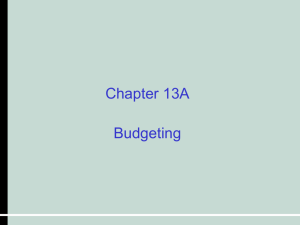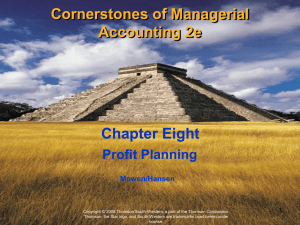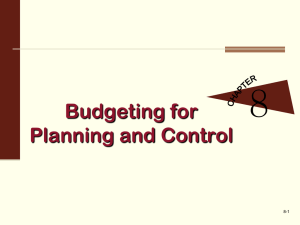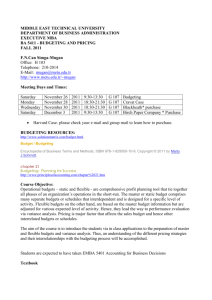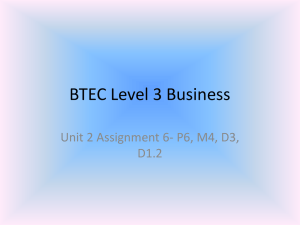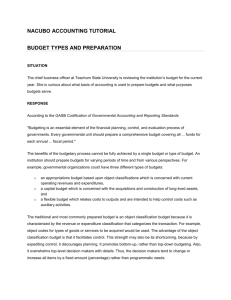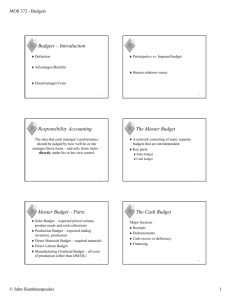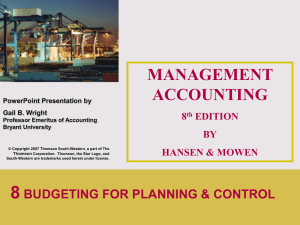Cash budgets
advertisement
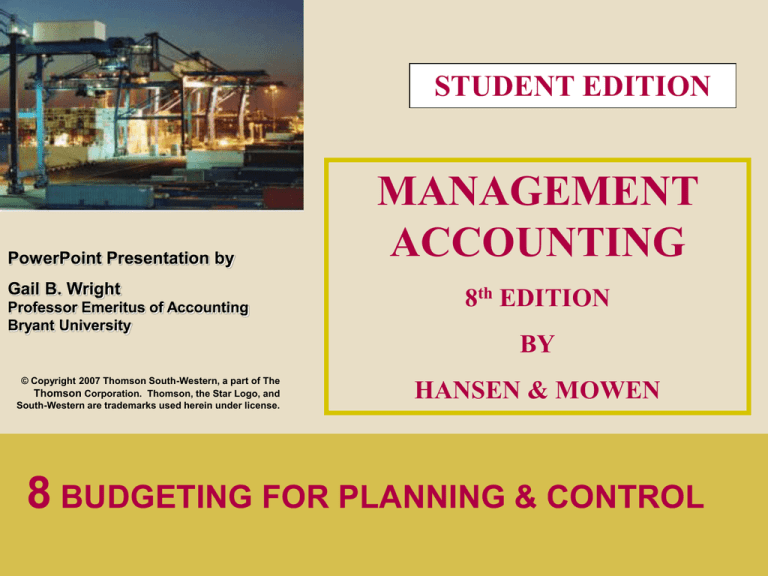
STUDENT EDITION PowerPoint Presentation by Gail B. Wright Professor Emeritus of Accounting Bryant University MANAGEMENT ACCOUNTING 8th EDITION BY © Copyright 2007 Thomson South-Western, a part of The Thomson Corporation. Thomson, the Star Logo, and South-Western are trademarks used herein under license. HANSEN & MOWEN 8 BUDGETING FOR PLANNING & CONTROL 1 LEARNING OBJECTIVES 1. Discuss budgeting & its role in planning, control, & decision making. 2. Define & prepare a master budget, identify its major components, & outline the interrelationships of its various components. Continued 2 LEARNING OBJECTIVES 3. Describe flexible budgeting, & list the features that a budgetary system should have to encourage managers to engage in goal-congruent behavior. 4. Explain how activity-based budgeting works. 3 LO 1 PLANNING: Definition Looking ahead to see what actions should be taken to realize particular goals. 4 LO 1 CONTROL: Definition Looking backward, determining what actually happened & comparing it with previously planned outcomes. 5 LO 1 Where do budgets fit into planning & control? Budgets are financial plans for the future, identifying objectives & the actions needed to achieve them. 6 LO 1 ADVANTAGES OF BUDGETING A budgetary system provides the following advantages: Forces managers to plan Provides information that can be used to improve improvedecision decisionmaking making Provides a standard for performance evaluation Improves communication & coordination 7 LO 2 MASTER BUDGET: Definition Comprehensive financial plan for organization as a whole. 8 LO 2 What is a “continuous” budget? A continuous budget is a moving 12-month moving 12-monthbudget budget, adding a month as each month expires. 9 LO 2 MASTER BUDGETS: Major Components Operating budget Operating Describes income generating activities of a firm Financial budgets Financial Detail inflows & outflows of cash 10 LO 2 OPERATING BUDGETS: Steps in the Process 1. 2. 3. 4. 5. 6. 7. 8. Sales budget Production budget Direct materials purchases budget Direct labor budget Overhead budget Selling & administrative budget Ending finished goods inventory budget Cost of goods sold budget 11 LO 2 FORMULAS: Production Units Except for JIT systems, production budgets must meet sales needs & satisfy ending inventory requirements. Units to be produced = Expected unit sales + Units in ending inventory – Units in beginning inventory 12 LO 2 TEXAS REX, INC.: Direct Materials Texas Rex, Inc., purchases 2 direct materials (DM) for production of its Texas Rex T-shirts: plain T-shirts & ink to produce the dinosaur logo. 13 LO 2 FORMULAS: Purchases Direct materials purchases budget tells amount & cost of raw materials purchased in each period. Direct materials (DM) purchased = DM needed for production + DM desired in ending inventory – DM in beginning inventory 14 LO 2 How do we determine the cost of finished goods ending inventory? Unit cost of finished goods is (per unit) DM + DL + Overhead. 15 LO 2 How do we project income from the operating budgets? Estimate selling & administrative expenses, then transfer all information into projected income statement. 16 LO 2 FINANCIAL BUDGETS 1. Cash budget 2. Budgeted balance sheet 3. Budget for capital expenditures 17 LO 2 What is the purpose of the cash budget? Cash budgets document the need for cash & the ability to repay debt. 18 LO 2 FORMULA: Cash Budget Projecting the ending cash balance includes cash collections, payments, & borrowings & includes minimum cash needed. Ending cash balance = Beginning balance + (cash receipts – disbursements) + (cash borrowing – repayments) 19 LO 3 Why are static budgets not good for performance evaluation? Actual level may Actual levelofofactivity activity may differ from the static budget level & misrepresent performance. 20 LO 3 FLEXIBLE BUDGET: Definition A budget for expected costs of a range of activity levels. 21 LO 3 How are budgets related to performance evaluation? Bonuses, salary increases, promotions are based on achieving or beating budget targets. 22 LO 3 What is participative budgeting? Participative budgeting involves subordinate managers in setting budget targets to achieve goal congruence. 23 LO 3 CONTROLLABLE COSTS: Definition Are costs whose level a manager can influence 24 LO 4 ACTIVITY-BASED BUDGETING Activity-based budgeting fits ABC & ABM systems. Budgets are developed for company activities to show the resources consumed. Can be done as a flexible budget. 25 LO 4 ACTIVITY FLEXIBLE BUDGET EXHIBIT 8-10 Budget can be developed based on different activity drivers. 26 LO 4 FLEXIBLE PERFORMANCE REPORT Performance report provides more relevant information when several activity drivers are used. EXHIBIT 8-11 27 CHAPTER 8 THE END 28

